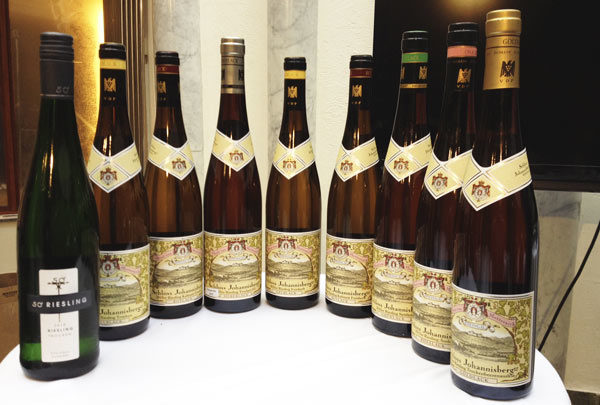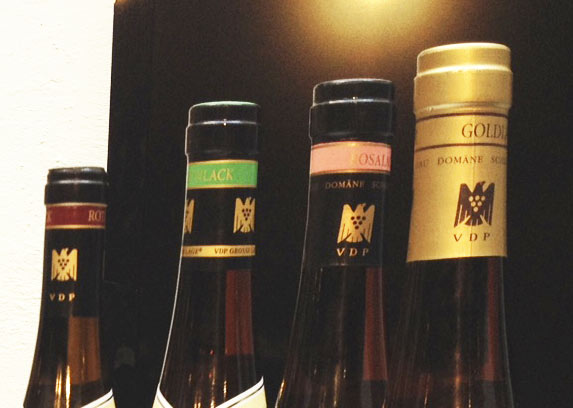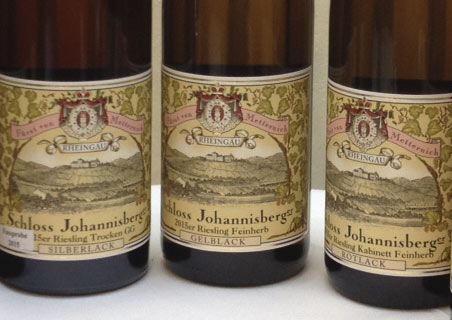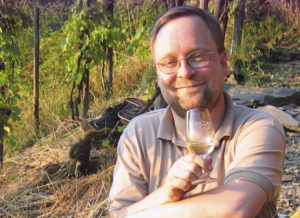Schloss Johannisberg in the Rheingau wine region is one of the most historic wine producers in Germany. They were the first German wine estate entirely planted with riesling, in 1720. It was also here that the German spätlese wine was produced for the first time, in 1775. At that time it was a mistake, because the courier who should announce the owner’s permission to harvest was delayed. Although a large part of the vineyard had by then been attacked by rot they still made wine from the grapes, and it proved to be an excellent wine. Therefore, they began to deliberately produce wines from grapes that were harvested late, which is just what Spätlese means. At a later date this type of wine has been divided into successively more “Praedikat” (prädikat) from Kabinett to Trockenbeerenauslese, depending on how mature and how much affected by noble rot the grapes are.
Besides the prädikat name on the label, Schloss Johannisberg uses different colours on the foil for different Praedikat. For example, red foil (Rotlack) is for the Kabinett and green (Grünlack) for Spätlese. The basic level without Praedikat has yellow foil (Gelblack). The colours were originally the colours of seal wax on the bottles. The latest addition to the paints is silver, which stands for Grosses Gewächs, the top dry wines.

In my opinion the Schloss Johannisberg style tends to the powerful and spicy for being Rheingau wines. There are other producers that focus more on steely structure or more on flowery style and perfumed tones. At the Gelblack and Rotlack levels the “power” may not always be so palpable, but the spices are usually there, compared to other wines at the same level. Minerality and elegance are also there in the wines at any level, because we’re talking about good quality Riesling. Schloss Johannisberg also uses a certain element of large oak barrels for their wines, and they are said to contribute to the spiciness. However, the oak dos not make itself known as actual oak barrels tones of the type which you get from new barriques.
What has happened since the early 2000s is that Schloss Johannisberg has returned to an excellent quality, and has moved towards production of more dry wines. However, they still make the exclusive noble sweet wines Trockenbeerenauslese (Goldkapsel) at the top level. Like many other German producers they sell relatively speaking more of the wines with residual sugar on the export markets, especially to the English-speaking countries.
Schloss Johannisberg sits on its own little hill, where they have 35 hectares of vineyards, just on the fiftieth parallel. Wines of different foil seal colour come from different parts of the vineyard. The basic level, Gelblack, comes from all of the vineyard holdings while Rotlack comes from the portion directly below the castle. Schloss Johannisberg is one of a few historical German estates that has its own official vineyard designation, without village name. The vineyard designation is therefore simply Schloss Johannisberger.
Since a few decades Schloss Johannisberg is owned by Henkell & Co., and operated together with G. H. von Mumm, which is a larger property with more spread-out vineyard holdings in the Rheingau. Henkell & Co’s Swedish branch recently hosted a very interesting tasting of the 2015 vintage from Schloss Johannisberg, which covered most Praedikat and wax seal colours, from dry to sweet.

The 2015 vintage
2015, which we tasted this time, is a very good vintage in Germany. The wine has good concentration and excellent purity, combined with fine acidity level, which together gives the wines great freshness and excellent balance on the sweet side.
Schloss Johannisberg’s wines from the 2015 vintage confirm an already good reputation for the vintage! Here the high quality is primarily demonstrated by the top wines, especially the dry Silberlack Grosses Gewächs and the sweet Rosalack Auslese.
The wines from Schloss Johannisberg
50° Parallel Riesling Trocken 2015
Qualitätswein, 8.3 g / l residual sugar, 12% alcohol. 85% of the grapes come from G. H. von Mumm, but the name comes from the latitude passing through Schloss Johannisberg’s vineyard. ~9 euro, also exists as bag-in-box.
Nose of peach, ripe apple, a little honey, lightly floral. The taste is dry (but the impression is not bone dry) and fruity with good acidity (but not extremely high), yellow and green apples and a light spiciness. 83-84 p.
This wine is produced in a relatively full-bodied style for an entry-level wine, and showcases more heavy and ripe grape aromas than the Schloss Johannisberger wines, but is significantly less perfumed than these.
Schloss Johannisberger Gelblack Riesling Trocken 2015
Qualitätswein, 8.3 g / L residual sugar, 12.5% alcohol. ~15 euro.
Nose with citrus, green apple, peach and a little hint of honey, discreet and good herbaceous tone, touch of spices, lightly perfumed. Here we clearly have an elegant and classic riesling aroma. The taste is dry and fairly fruity with green apple, citrus, good acidity (but not too high) and minerals. The aftertaste is fresh with green apples, and some minerals. Good now, but can be stored, 85-86 p.
There is clearly more citrus notes than in the 50° wine, more focus on elegance, and more concentration of flavour. Gelblack is also more ready to drink than the wine one notch up, the Rotlack.
Schloss Johannisberger Gelblack Riesling Feinherb 2015
Qualitätswein, 14 g / L residual sugar, 11.5% alcohol. ~15 euro.
The nose is very similar to the dry Gelblack, possibly there is a little more honey and dried fruit. The taste is almost dry, with green apple, citrus, good and relatively high acidity; it actually feels a little higher than in the dry wine. The aftertaste is fresh and dry with green apple and some minerals. Can develop further, 85 (+) p.
Both Gelblack and Rotlack are available in two versions, one dry and one with a bit more residual sweetness designated as feinherb. In this case, the extra sweetness is not at all significant.
Schloss Johannisberger Rotlack Riesling Kabinett Trocken 2015
6.7 g / l residual sugar, 11.5% alcohol. ~20 euro.
Nose with green apple, citrus, light green tones, lightly perfumed, elegant. The taste is dry with citrus, green apple, high acid and some minerals. The aftertaste is fresh with green apples and some minerals. Good now, but would benefit from ageing, 86 + / 87 (+) p.
The nose is relatively similar to Gelblack, but is a bit more elegant and less spicy. The taste is more green apples, less spicy and more dominated by the acidity, which makes me think it has more to gain from ageing. It is interesting that this wine is lower in alcohol than Gelblack, which is not because Gelblack is chaptalised, but because Rotlack is made in a different style.

Schloss Johannisberger Rotlack Riesling Kabinett Feinherb 2015
20.2 g / L residual sugar, 11% alcohol. ~20 euro.
The nose is very much like the dry Rotlack, but with a little more honey tones and possibly a little more spice. The taste is about semi-dry (in other words, the sweetness is not too noticeable) with peach, other stone fruits, citrus, green apple, good acidity and some spices. The aftertaste is fresh with green apple. Good now, but can be aged, 86 (+) p.
Here the residual sugar is slightly higher than the Gelblack Feinherb, which also corresponds to a more distinct sweetness, and a not as noticeable acidity. However, it is not a question of a “totally sweet” Kabinett with 50 g / l or more, since Schloss Johannisberg does not produce that, even if did in ancient times.
Schloss Johannisberger Silberlack Riesling Grosses Gewächs 2015
3 g / l residual sugar, 12.5% alcohol, made with skin contact for 25 hours.
Powerful and complex aroma with ripe yellow apple, citrus and citrus peel, some yellow plums, a little peach, light spices possibly indicating nicely managed barrels in the background, hint of beeswax, lightly floral. The taste is dry with good concentration and substance, citrus, green apple, spices, clear minerality, and a good and relatively high acidity. The aftertaste is long and complex with intense mineral tone. The wine is young and drinks well now, but have a clear potential for development, 93 (+) p.
This wine is the dry top of the range wine, and represents a substantial jump up in power, concentration and complexity from the Rotlack level. (Honestly, it would not hurt if, as used to be the case, there was a Grünlack Trocken between these two, with more weight than Rotlack but at a little lower price than Silberlack.)
The Silberlack’s winemaking, with some skin contact, further underlined the spicy “house style”, while the wine has a very noticeable minerality. Fermentation was unusually fast this vintage, and several barrels ended up all the way down to zero grams of residual sugar, so the wine is analytically unusually dry. The taste reveals, however, that the wine is not “chablis dry” but it has thanks to its body a normal taste for a good GG.
Schloss Johannisberger Grünlack Riesling Spätlese 2015
77.3 g / l residual sugar, 8.5% alcohol, made from ripe grapes but without noble rot.
Nose with citrus along with some citrus peel, peach, some honey, some spices with a subtle hint of barrels, perfumed. The taste is semi-dry / semi-sweet with good concentration, honey, peach, high acidity that really balances the sweetness, light spiciness, green apples in the mid-palate and a fruity taste with honey and green apple that finishes fresh and dry. A young wine, good now, but could be even better with some ageing, 89 (+) p.
This is, as it should be, a really good Spätlese and the wine has much more depth and weight of aromas than Rotlack. On the Grünlack level there is now only one “fully sweet” wine, and no version with less sweetness. The last Grünlack Trocken was produced in the vintage 2007 and has been replaced by Silberlack, which, however, has been sharpened into a heavier style. It should be mentioned that today’s Spätlese is not really the same type of wine that was produced in 1775, since it does not contain any nobel rot grapes. Probably an Auslese of today would be closer in style to that wine.
Schloss Johannisberger Rosalack Riesling Auslese 2015
128.4 g / l residual sugar, 7% alcohol, produced with about 30% of botrytis grapes.
Complex and fresh scent of peach, a little dried apricot, orange, botrytis, honey, a little musk, minerals and perfume. Just over medium sweet and fresh taste, high acidity, citrus, a little green apple, honey, peach, some apricot, and a long finish with citrus, honey and minerals. Young, can definitely develop further, 94 (+) p.
This is a very good Auslese with really nice acidity and good mineral touches. There are real concentration in the wine and hints of botrytis, but it has a fresh rather than heavy nose, and also a fresh taste with lots of mineral. For a sweet wine this combination is very likeable. In the taste you clearly feel the character that vintages with high acid usually give. Although I have given the Goldlack a higher score, because it is an exceptional wine, to some extent it was Rosalack that impressed the most in his weight class (with Silberlack just a nose length after).
Schloss Johannisberger Goldlack Riesling Trockenbeerenauslese 2015
267.2 g / L residual sugar, 7% alcohol. The grapes were harvested on October 25 and the total production was 400 litres.
Heavy, concentrated and complex aroma dominated by dried apricots with spicy honey, exotic fruit, a bit of smoke, musk and some beeswax. The flavour is very sweet and viscous with honey, dried apricot, exotic fruit, spices, good acidity with freshness, and a long aftertaste. Young, good now, but can be aged for a minor eternity, 96 p.
2015 was also the first time since 2011 that Schloss Johannisberg produced a Goldlack. Their Eiswein, Blaulack, has not been produced since in 2008.
Tomas Eriksson is one of the contributors on BKWine Magazine. He is active in the wine tasting association AuZone in Stockholm and in Munskänkarna, where he sometimes holds wine courses. Tomas also runs a blog called Vintomas.











One Response